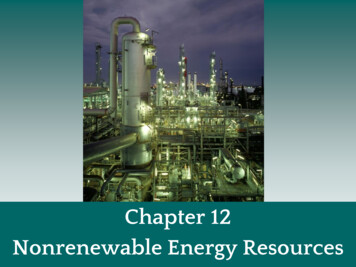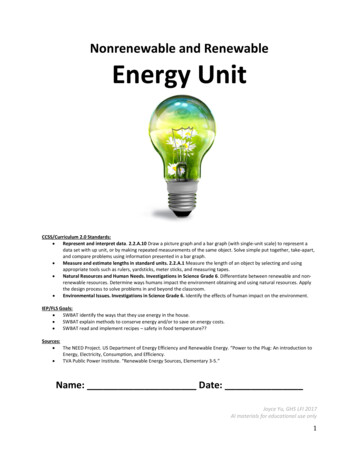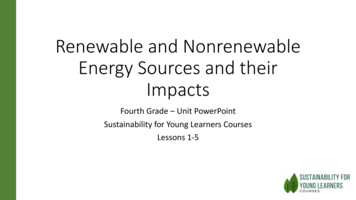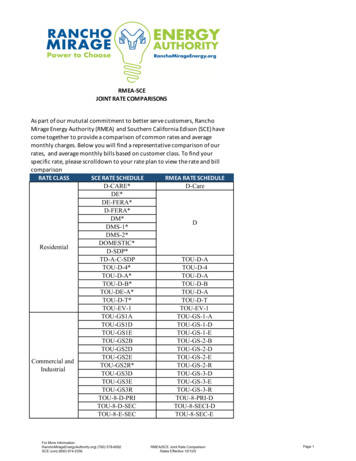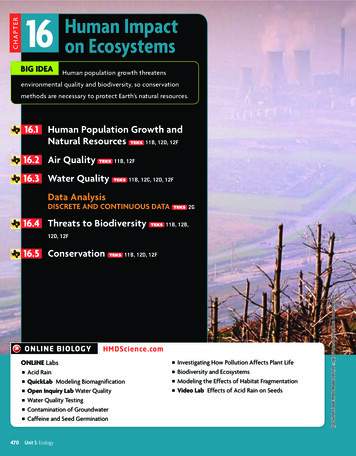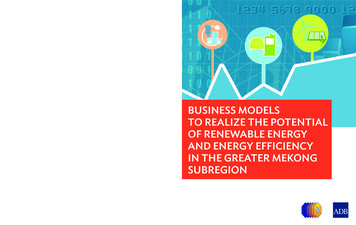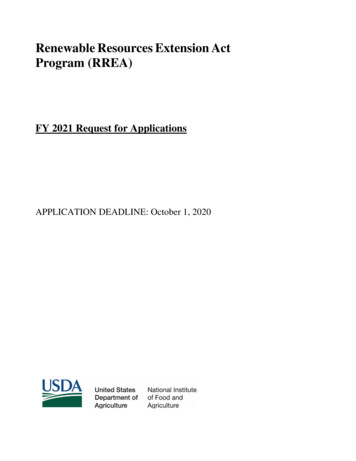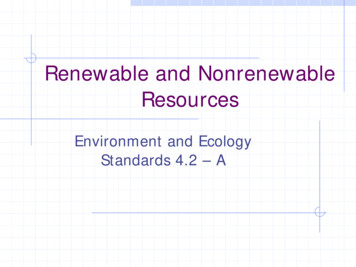
Transcription
Renewable and NonrenewableResourcesEnvironment and EcologyStandards 4.2 – A
1. Natural ResourcesAll of the Earth’s organisms, air, water,and soil, as well as materials such asoil, coal, and ore that are removed fromthe ground.Separated into two broad categories: Renewable resourcesNonrenewable resources
2. Renewable ResourcesAre any resourcethat cycles or can bereplaced within ahuman life span.Examples include:water, crops, wind,soil, sunlight,animals, etc
a. Food and fiber –are renewableagriculturalresources that canbe harvested orraised indefinitely unless their useexceeds the ratethey can bereplaced.b. Soil – a mixture ofliving organismsand dirt.Even though itinitially takesthousands of yearsto form, the rate atwhich soil canregeneratedepends on theclimate of an area.
c. Wind – caused bythe uneven heatingof the Earth. Notonly renewable butinexhaustible.d. Sun – light fromthe sun supportsall the life on Earthas we know it.Also consideredinexhaustible. (atleast for the next 5billion years)e. Water – constantlyrenewed/replenishedby the water cycle.However, fresh waterresources aresomewhat limited.The use and quality ofwater must becarefully monitoredto ensure future use.
f. Biomass fuels – are g. Geothermal energyorganic matter(wood, plants,animal residues,etc ) that containstored solarenergy.Used to supply energyto 15% of theworld’s supply.– the heatgenerated deepwithin the Earth.Fueled by thedecay ofradioactiveelements. Used toheat water.
3. Nonrenewable ResourcesAny resource that cannot be replacedduring the time of a human life span.Took thousands of years to form andexist in fixed amounts in the Earth.They need to be conserved before theybecome depleted.
a. Ores – mineraldeposits fromwhich valuablemetals andnonmetals can berecovered forprofit.Metallic ores include:gold, silver,copper, aluminum,zinc, etc Nonmetallic oresinclude: salt, sand,gravel, clay,diamonds,gemstones, etc.Currently there are nometal mines inoperation in PA.The major nonmetallicores mined are coal,limestone, granite,slate, sand, andgravel.
b. Fossil FuelsAre nonrenewable because they takethousands of years to form.In developing countries, the fossil fuelsare fossilized wood, charcoal, and peat.In developed countries, the fossil fuelsare mainly coal, natural gas, and oil.
i. Coal – the remainsof wetland plantsthat have beencompressed overmillions of years.Different types –Peat – about 50%carbon. The rest iswater andcontaminants.Lignite (brown coal)– about 70%carbon.Bituminous (softcoal) – about 85%carbon.Anthracite (hardcoal) – greater than90% carbon. This isthe cleanest burningand least abundant.
PEATLIGNITEBITMUNOUSANTHRACITE
Most of the coal fields in Western PAare bituminous coal whereas the coalfields in Eastern PA are anthracite.Russia produces about 50% of theworld’s supply of coal. China producesabout 20%. The U.S. produces about15% of the world’s supply.
ii. Petroleum andNatural Gas – arethe remains ofmainly marineorganisms.Typically found inundergroundformations calledtraps with thenatural gas trappedon top and oil onthe bottom.Currently, PA doesnot producesignificant amountsof oil and gas butthe beginning of theU.S. oil boom in the1800’s started inTitusville, PA.
4. Global Energy Use andProduction.Energyconsumptionincreased by 50%from 1973-1993.Expected tocontinue toincrease in thefuture mainly indeveloping orthird worldcountries.
Remember that using more fossil fuelsaccelerates the global warming trenddue to more greenhouse emissions andpollution.What other effects will a growth inglobal energy use produce?
5. Alternative EnergyResources.a. These are energy resources that aremore renewable or moreenvironmentally friendly in comparisonto fossil fuels.b. Currently include the following: solar,wind, geothermal, hydropower,nuclear, and biomass.
i. Solar energy – canbe used to heatbuildings andwater and provideelectricity.Passive solarheating uses largesouth facingwindows to collectthe sun’s energy.
Solar cells cancollect and convertthe sun’s energyinto electricity forresidential use.
ii. Wind – turns giantwind turbines thatproduce electricity.Currently, there areabout two dozenwind turbines in PA.Several are locatedin Somerset, PAnear the turnpike.
iii. Hydropower – theenergy of waterstored behind damscan be turned intoelectricity.Currently, there are23 dams in PA thatproduce electricity.
iv. Nuclear Power – uses the process of fissionto release energy to make electricity.Produces about 20% of the electricity in theU.S.Currently, PA has five nuclear powerplants.(Beaver Valley, Susquehanna, ThreeMile Island, Limerick, and Peach Bottom.In 1979, there was a partial reactormeltdown at Three Mile Island. Thisbrought a halt to nuclear development inthe U.S. There have been no new plantssince.
Three Mile Island
v. Trash – burning trash to produce electricity.Currently, PA has seven waste-to-energy plantsthat burn close to 19 million tons of waste a year.
Availability of ResourcesEnvironment and EcologyStandards 4.2.B
Almost every resource needs to beremoved from the Earth andprocessed in some way before it canbe used.What ultimately determines theavailability of resources are the costsinvolved in removing/extracting itfrom the Earth and the costs involvedin processing/refining them intoproducts.
1. Removing/ExtractingEarth’s Resources –Over time, technologyhas increased theefficiency of obtainingour natural resources.A. Farming practices– changed from manyhuman/animal laborto increased use offarm machinery.
fields in Eastern PA are anthracite. Russia produces about 50% of the world's supply of coal. China produces about 20%. The U.S. produces about 15% of the world's supply. ii. Petroleum and Natural Gas- are the remains of mainly marine organisms. Typically found in underground formations called

